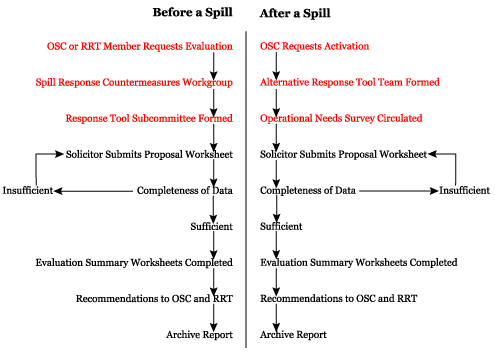Alternative Response Tool Evaluation System (ARTES)
During an oil or chemical spill, the On-Scene Coordinator (OSC), who directs the response, may be asked to consider using a non-conventional alternative countermeasure (a method, device, or product that hasn't typically been used for spill response). To assess whether a proposed countermeasure could be a useful response tool, it's necessary to collect and evaluate quickly the available information about it.
To aid in evaluating non-conventional alternative countermeasures in particular, the Alternative Response Tool Evaluation System (ARTES) was developed. ARTES can also be used to evaluate proposed conventional countermeasures. It is designed to evaluate potential response tools on their technical merits, rather than on economic factors. ARTES is designed to work in concert with the National Contingency Plan (NCP) Product Schedule and the Selection Guide for Oil Spill Response Countermeasures.
Under ARTES, an Alternative Response Tool Team (ARTT) rapidly evaluates a proposed response tool and provides feedback to the OSC in the form of a recommendation. The OSC then can make an informed decision on the use of the proposed tool. A set of forms has been developed for use in the ARTES process.
ARTES was designed by workgroups of Regional Response Teams (RRTs) II and III. (RRTs are teams of federal and state response agencies.) ARTES is now in place in most RRTs.

ARTES is designed for two uses:
- to evaluate a product's appropriateness for use during a specific incident, under specific circumstances.
- as a pre-evaluation to identify conditions under which favorable outcomes are anticipated when a product is used.
An advantage of ARTES is that it provides a management system for addressing the numerous proposals submitted by vendors and others during a spill. Subjecting all proposals to the same degree of evaluation also ensures that vendors are considered on a "level playing field."
ARTES can be used before an incident as well as during a response. If an OSC would like to consider an alternative response tool during pre-spill planning, he or she can use ARTES to evaluate the tool. Over time, the hope is that having a record of proposals on file will enable an OSC to address alternatives for future needs.
There are two ways that the ARTES process can be initiated, generally speaking:
- When no spill response is in progress, a vendor can approach the OSCs (federal or state) or Regional Response Team (RRT) members to request that a product be evaluated. It then falls on the OSC or RRT representative to determine the value of performing an ARTES evaluation on the product. In effect, the OSC and RRT representative perform first-line screening. If either the OSC or RRT representative decides that it would be appropriate for a product to be evaluated, he or she then must submit a written request for an ARTES evaluation to the Spill Response Countermeasures Workgroup chairperson at the appropriate RRT.
- During a spill, only the OSC, the Unified Command, the Planning Section Chief, or the Operations Section Chief can initiate an evaluation. They would do so in response to an identified need.
Either before or during a spill, once a proposed response tool passes this initial screening step, it must be thoroughly evaluated. The vendor needs to provide complete and comprehensive information on the product by filling out the Proposal Worksheet (PWS). The information in the PWS is then reviewed by a Response Tool Subcommittee (during the planning phase) or by the Alternative Response Tool Team (during spill response operations). If the PWS is sufficient, the teams evaluate the data, provide recommendations (either to accept or not accept) to the RRT and OSC, and the report is then archived.
Completion of an ARTES evaluation does not mean that a product is pre-approved, recommended, licensed, certified, or authorized for use during an incident. Spill response products such as dispersants, shoreline cleaners, and biological agents must conform to federal regulations meant to protect our water resources and ensure that products used for spill response undergo review and testing before they are approved for use. Products are listed on the National Contingency Plan (NCP) Product Schedule.
Disclaimer: The listing of a product on the Product Schedule does not mean that EPA approves, recommends, licenses, certifies, or authorizes the use of the product on an oil discharge. The listing means only that data have been submitted to EPA as required by Subpart J of the National Contingency Plan, Section 300.915. (Source: 40 CFR §300.920 (e))
An OSC need not wait for the ARTES recommendation when deciding whether to use a response tool. ARTES is designed to help, not hinder, the OSC.
ARTES Forms
Alternative Response Tool - Proposal Worksheet (PWS) [PDF, 77 KB]: The Proposal Worksheet (PWS) is the initial information requested from a vendor prior to an evaluation. This is the sheet that someone asking for an ARTES evaluation must use to submit their data.
Alternative Response Tool - Data Evaluation Worksheet (DEW) [PDF, 228 KB]: The Data Evaluation Worksheet (DEW) is the form used by the ARTES review committee to evaluate a product.
Alternative Response Tool - Summary Evaluation Worksheet (SEW) [PDF, 218 KB]: The Summary Evaluation Worksheet (SEW) is the final sheet filled out by the review committee, sent to the vendor (submitter) and archived with the District Response Advisory Team (DRAT; U.S. Coast Guard spill responders who support the OSC).
Alternative Response Tool - Operational Needs Survey (ART-ONS) [PDF, 48 KB]: The Operational Needs Survey (ONS) is used only during an actual spill. It is used by the Operations or Planning Section to identify short-term or long-term needs. That information is then used to solicit technologies to fill those needs.
 An official website of the United States government.
An official website of the United States government. 